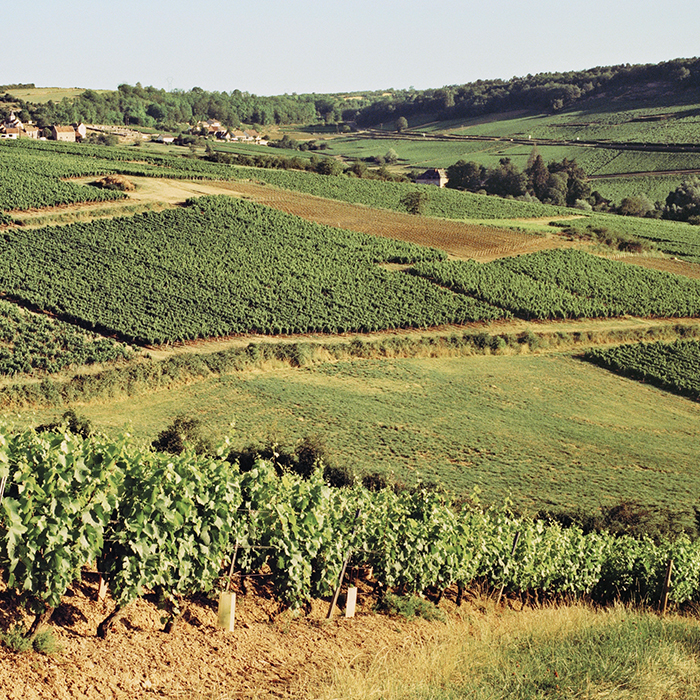Burgundy 2018: where to find value
Author: Mark Pardoe MW

Nothing in Burgundy is made in large volumes. The most famous wines are almost impossible to find, as the tiny quantities usually have to be allocated, and prices for these rarities are high. But there are ways you can get a foothold on the Burgundy ladder and find wines that give the thrill of Burgundy’s unique qualities – without having to break the bank.
Big names, “lesser” wines
The one immutable fact about Burgundy is that the name of the producer is the most important guarantor of quality. Great producers make excellent wines at all levels. While their top wines may command eye-watering prices, almost all Burgundians have a broad portfolio, running from the generic to the great. They may cost a little more than their peers, but don’t hesitate to pick up these “lesser” wines when they are made by Burgundy’s most admired producers.
- 2018 Mâcon-Milly-Lamartine, Clos du Four, Les Héritiers du Comte Lafon
- 2018 Chorey-lès-Beaune, Les Bons Ores, Domaine Guyon
Non-village village wines
A lot of Bourgogne Rouge and Blanc is created by blending across the region but, at smaller growers, some generic wines are created from vineyards situated only around the famous villages. Although less intense and to be drunk young, in the right hands these wines can capture the essence of a village’s character, be it the steely minerality of Puligny, the silky intensity of Vosne or the floral delicacy of Chambolle. There is no way of knowing from the label. Be sure to check our tasting notes, which always aim to show each wine’s provenance.
- Puligny-style white: 2018 Bourgogne, Oncle Vincent, Olivier Leflaive
- Gevrey-style red: 2018 Bourgogne Rouge, Domaine Castagnier
- Vosne-style red: 2018 Bourgogne Rouge, Domaine Jean Grivot
- Chambolle-style red: 2018 Bourgogne Rouge, Les Bons Bâtons, Domaine Michèle & Patrice Rion
Climate change vineyards
Burgundy’s quality hierarchy is based on the empirical observation of each vineyard’s ability to ripen fully and, for centuries, those vineyards on the best soils and situated mid-slope have been identified as prime land. The converse is that vineyards that struggled to ripen, although on good soil, were not so well regarded. But as climate change brings earlier harvests, these out-lying vineyards are coming into consideration. Look at wines from villages tucked into the valleys, such as St Aubin, Pernand-Vergelesses and St Romain for whites, or higher locations, like Monthélie and Blagny for reds.
- 2018 St Aubin, En Remilly, 1er Cru, Domaine de Montille
- 2018 Pernand-Vergelesses Blanc, Les Cloux, Domaine Rollin
- 2018 St Romain, Sous le Château, Olivier Leflaive
- 2018 Blagny, La Pièce Sous le Bois, 1er Cru, Benjamin Leroux
- 2018 Monthélie Rouge, Domaine de Montille
Look for old vines
As vines age, their yield reduces and the fruit gathered is more concentrated. This quality is much prized as, although the volumes produced are smaller, quality and intensity are enhanced. This is seen as a particular benefit to Burgundy’s great wines, but there is a win lower down the scale as well. Many producers still prefer to keep as many old vines as is practical, even though this is a more commercially challenging decision. Sometimes producers will label their wines as “vieilles vignes”, but there is no legal definition of an old vine, so others may not.
- 2018 Bourgogne Blanc, Vieilles Vignes, Jean-Philippe Fichet
- 2018 Bourgogne Aligoté, Domaine du Comte Armand
- 2018 Bourgogne Passetoutgrains, L’Exception, Domaine Michel Lafarge
Halo effect villages
As demand for the great names of Burgundy increases, it pays to keep an eye on their neighbours. Santenay borders Chassagne where the soil turns more to red wine territory (for the same reason, do not underestimated Chassagne’s reds, for which it was once more famed), Auxey-Duresses has much in common with Meursault, whereas in the north, Fixin borders Gevrey-Chambertin and itself runs into Marsannay. Do not necessarily expect the finesse of the more renowned villages, but you will find very worthy and delicious wines.
- 2018 Auxey-Duresses, Domaine du Comte Armand
- 2018 Santenay, Clos des Mouches, 1er Cru, David Moreau
- 2018 Fixin, Les Arvelets, 1er Cru, Domaine Lignier-Michelot
- 2018 Marsannay Rouge, Clos du Roy, Domaine Jean Fournier
Flying south
With the price of land in the Côte d’Or increasingly prohibitive, many producers are looking south to the Côte Chalonnais, Mâconnais and Beaujolais. A much greater understanding of these regions’ terroir has catalysed a resurgence in quality, led by existing domaines and now joined by increasing numbers of renowned producers from the Cote d’Or, keen to make wines that are both affordable and of quality in line with their own reputations, and thus able to offer wines with their imprimatur to their growing bands of customers.
- 2018 St Véran, Côte Rôtie, Olivier Merlin
- 2018 Rully Rouge, La Chaume, Domaine Jean-Yves Devevey
- 2018 Maranges, Le Croix Moines, 1er Cru, Camille Giroud
- 2018 Moulin-à-Vent, Les Brussellions, Domaine Louis Boillot
Head for the hills
Although much of the traditional focus on Burgundy is on the precious vineyards of the Côte d’Or, there are also vineyards in the higher country to the west, behind the famous hills. There is some fine terroir here and, in centuries past, some villages were held in very high regard. The themes are well-known: a new generation of vignerons, better vineyard management, climate change, a better understanding of the market, and a quality halo effect from the famous wines; all these influences are helping to support wines that offer both value and interest.
- 2018 Bourgogne Hautes Côtes de Beaune Blanc, Sous Eguisons, Domaine Jean-Noël Gagnard
- 2018 Bourgogne Hautes Côtes de Beaune Rouge, La Perrière, Domaine Denis Carré
Explore the full list of Mark’s recommendations here, or browse all Burgundy 2018 En Primeur at bbr.com/burgundy2018


